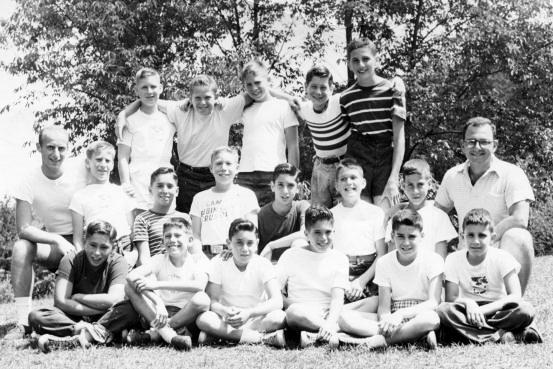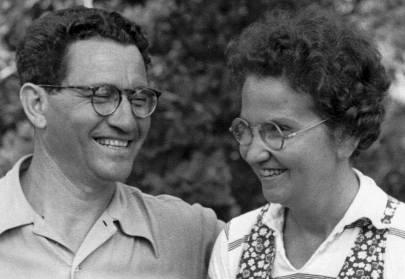
From the summer of 1929 through 1931, the camp was located on a peninsula on Bailey Island, in Casco Bay, south of Brunswick, Maine. A small island just off the shore, called "Robinson Crusoe Island", gave the camp its name. The camp moved to Sturbridge in the summer of 1932. Josh had immigrated to New York when he was 11, from an impoverished shtetl in Russia. He knew no English when he arrived, and his total formal education was two years of elementary school. Yet at least two ex-campers who knew Josh assumed that he had been a graduate student in education who had studied with John Dewey. Note 1 I'm into my fifth year of writing this blog. This is my 216th entry, and I've previously written ten entries that touch on the camp. Yet it occurred to me that I've never written an entry with a basic introduction to the camp, and a discussion of why it was so important to me. I've put this entry in the first position under the *CAMP keyword on the Keyword list. Much of its text has been gathered together from earlier entries, and from my Camp Robinson Crusoe web pages (more about them later). The subject came to mind because a video documentary on the camp has been made by filmmaker Bruce Butcher, and its première will occur on April 5, 2014, near the former camp grounds. This will bring together a substantial number of ex-campers. So far, more than 125 ex-campers and guests have signed up to attend. The documentary is called Camp Robinson Crusoe, My Heart Will Always Here Belong. For its time, Camp Robinson Crusoe ("CRC") was extremely innovative. It was co-ed, in the sense that both boys' and girls' groups shared the camp, although there were separate bunks for each sex. At the time, it was more common for boys' and girls' camps to be entirely separate. CRC was non-competitive, dispensing with traditional camp activities such as "color wars". Centered around small groups that lived in rustic bunks, the camp was quite democratic, allowing a lot of space for individual activities. Each bunk voted on a group activity for the morning, and then campers were free to sample various individual activities in the afternoon. It was not possible to attend for only a portion of the summer; campers had to enroll for the full eight weeks. Parents were only allowed to visit during two specified visiting days in the middle of the summer. The counselors arrived for training several days before the campers. I first attended the camp as an "Intermediate boy" in 1952, at the age of ten, and I remained a camper through 1957. Here's a photo of my group in my third year at camp - I'm at the right end of the front row. I was twelve years old:  When the campers reached 13 to 14 years of age, they moved to a separate part of the camp called "Primitive", in which the campers lived in tents rather than bunks, pumped their own well water, cut their own wood for the wood-burning stove in the kitchen, and cooked their own meals. In the Primitive groups, the girls' and boys' groups were combined. During the Primitive summers, the camp ran some very nice off-site camping excursions. These trips generally lasted five days, and included things like a canoe trip down the Connecticut River (from Windsor Locks to Essex), a hike to the summit of Mount Washington (in New Hampshire), and camping on the beaches of Cape Cod and Martha's Vineyard (Massachusetts). Why was the camp so important to me? It was a happy part of my youth - I spent six years there as a camper, and two more years as a counselor-in-training. I loved being a camper. Something new seemed to happen almost every day. I learned how to swim, canoe, and sail at CRC. I was particularly attracted to the Nature Lab, shop, and photo lab. I learned riflery, and was pretty good at it. I attained a rating of Sharpshooter as a member of the Junior Division of the National Rifle Association (an organization which today I find abhorrent). But lots of people have fond memories of their summer camp experiences, whatever camp they attended. Did the innovative nature of Camp Robinson Crusoe make a difference? Perhaps I would have been happy wherever I spent my summers. Or perhaps not. Most summer camps of the time, and to this day, hire college students as counselors, with mixed results. At Robinson Crusoe, many of the head counselors were experienced teachers, and were quite adept at dealing with the campers. I was a cerebral, very non-athletic kid in a group that was fixated on baseball, but nevertheless I felt myself part of the group. In my first summer, this was in no small measure due to the efforts of my bunk's talented head counselor, Larry Paley. It also helped that the camp deliberately avoided the hyped-up competitive aspects of many other summer camps. So yes, I think my good experience at Robinson Crusoe was not entirely an accident. My experience at CRC may also have been influenced by the other campers. It was an expensive camp, and was populated primarily by upper-middle class, intelligent, college-bound youngsters, mostly from in and around New York City. Many ex-campers have fond memories of their time there, particularly those who attended for many summers. Years later, my own children had good experiences at Camp Med-O-Lark, in Washington, Maine. Like Robinson Crusoe, it was very well run. When interviewing the director before signing up for a summer, I was surprised to find that very few campers spent more than a summer or two there. To me, my experience of having spent eight straight summers in one place seemed normal (six as a camper, and two as a counselor-in-training). The director noted that there are now many more opportunities available than there were in my youth. Older students today might spend a summer touring Europe, for instance, something that was prohibitively expensive back in the days before cheap airfare. I was also surprised by what struck me as the small physical size of Med-O-Lark, although it's nicely placed on a lake. Robinson Crusoe was the only camp I had ever known, so its 400 hectares (1,000 acres) seemed "normal" to me. In fact, Med-O-Lark's situation is more typical of summer camps - better than most, in fact. Robinson Crusoe's campus was extraordinary. We'd hike all morning, up and down over seven high ridges deep in the woods, to have lunch sitting in the cool adit of an old lead mine. And the entire hike was on camp land, until we reached the mine itself. Note 2 My younger daughter Sara had a camp experience that was as important to her as CRC was to me, although it was at a day-camp, not a sleep-away camp. It's called Mazemakers, and it still exists - it's now part of Weston's Meadowbrook School. We signed Sara up for the first four-week summer session. When we picked her up at the end of the first day, Sara asked, "Can I also go to the second session?". It had taken only a day for her to conclude that Mazemakers was a great fit for her. She loved it, and now describes it as one of the major influences in her life. She attended as a camper for many years, then became a staff member, and ultimately a director. Yet at least one parent we knew was not happy with Mazemakers, because he didn't consider it sufficiently competitive. As far as he was concerned, his son was preparing for a competitive world, and that involved learning in a competitive environment. He might not have been happy with Robinson Crusoe either, I suppose. In 1999, a camper from my group, Robert Handloff, organized a reunion of ex-campers (you can see him in our group photo, third from the left, in the second row). It was held on the site of Camp Taconic in the Massachusetts Berkshire Mountains (CRC having closed in 1970). I took photos at the reunion with a conventional 35mm film camera, the technology of the day (only 15 years ago). I dropped off the film to be developed on the way back home from the reunion, and ordered the photos to be scanned onto a CD-ROM. I picked them up and posted them on my website the next day. Since then, my CRC pages have grown helter-skelter, as I've added additional material from time to time. In 2011, I added content from a page on the camp being supported by ex-camper Donna Lewis. The camp pages have thus become rather extensive. If this blog entry causes you to want to learn more about the camp, and to see additional photos, you can follow that link. Numerous former campers searching on the camp's name have come across my pages, and have contacted me over the years (my e-mail address is available on the site). I've added them to my list of ex-campers, and sometimes put them in touch with other camp friends. Thus my web site has brought many people together who might not otherwise have gotten in touch. There's now a Camp Robinson Crusoe Facebook page (started by Donna Lewis), and ex-campers communicate there as well. You don't need to be a member of it to see it - just click on that link. I noted earlier that the camp deserves a "keyword" of its own on my blog, *CAMP. Ten blog entries written prior to this one have that keyword. If you click on the word *CAMP in the footer of this entry, and then click on *CAMP again in the footer of each blog entry that pops up, you'll see all the entries that relate to the camp in some way. At some point, I think partly to finance his retirement, Josh Lieberman sold the camp's land to the adjacent Old Sturbridge Village ("OSV"), with the proviso that the camp could remain on the land as long as it continued to operate. After the camp closed unexpectedly in 1970, OSV considered plans for a mill village, but were unable to fund it. Ultimately, they sold the land to the Town of Sturbridge, for recreational use. The camp land is now called the Leadmine Mountain Conservation Land, and is open to the public. You can see a trail map here.
  Note 1: A bit more about Josh and Leah: Josh's book Creative Camping describes his experiences running a youth labor camp in the 1920s. The book makes it clear that Josh had developed and implemented his group-centered approach to running a camp prior to starting Camp Robinson Crusoe. Josh and Leah's granddaughter Ditte Frederiksen McNeil wrote:
Note 2: Don't you do crossword puzzles? There are quite a few words I learned only because they commonly appear in crossword puzzles. In order to make puzzles with the sort of dense interconnection common in English puzzles, the puzzle writer needs to use words that contain a lot of common letters. "Adit", obviously, has two vowels, the most common consonant ("t"), and another consonant which is reasonably common. An adit is a mostly horizontal entrance to a mine. Once again from Josh and Leah's granddaughter Ditte Frederiksen McNeil:
 |
